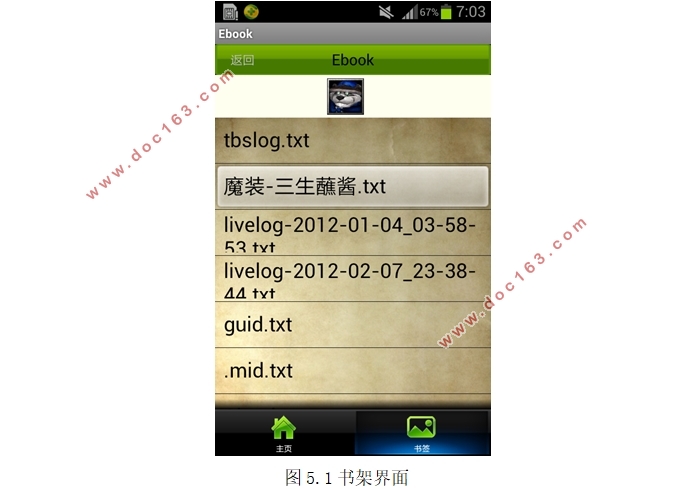基于安卓Android手机电子书阅读器APP的设计

基于安卓Android手机电子书阅读器APP的设计(任务书,开题报告,中期检查表,外文翻译,论文12000字,程序代码)
摘要
人们获取知识的一个主要途径就是阅读。千百年来,人类阅读的媒质由陶器、兽骨、铜器、石刻到竹简,最后发展为纸张,甚至在步入IT时代后,出现了数字形式的电子书籍。阅读媒质的变化体现了人类社会的发展进步,也影响着人们的阅读体验。随着智能手机的大范围普及,手机已经不仅仅是人与人通话的工具,更是人们获取信息资源的一种重要方式。电子书逐渐取代传统的纸质媒质,一来是顺应当今IT时代的结果,使得人们随时随地可以轻松获取自己想要的信息;二来也符合环保的理念,大大地减少了纸质的印刷与浪费;再者,电子书产业大大简化了传统出版的繁琐步骤,节省了出版的成本。因此电子书阅读可以说是大势所趋,而一款优秀的移动端电子书阅读器很大程度上决定了用户体验。
本文基于Android平台的特性,设计并实现了一款可应用于Android系统的电子书阅读器,可以读取SD卡里的txt文件并进行阅读。阅读时还可以设置改变背景颜色、自动翻页、调节字体大小等,交互界面友好。
作者的主要研究工作如下:
1.查阅了大量资料文献。了解国内外的电子书阅读器发展现状,了解市面上已有的电子书阅读器的功能及优缺点,对电子书阅读器进行了需求分析; [来源:http://Doc163.com]
2.研究并实现了电子书阅读器的UI设计。主要的界面包括书架界面和阅读界面,书架界面采用列表的布局方式显示txt电子书,整体界面简洁舒适;
3.研究并实现了电子书阅读器的功能设计。包括扫描SD卡、添加电子书到书架、添加书签、书签跳转、背景颜色设置、动态翻页、自动翻页、字体大小设置等,使软件不仅具有了基本功能,还有一定的功能性能给用户带来便利和良好的使用体验;
4.分别在虚拟机和Android真机上测试了设计的电子书阅读器,测试结果证明软件运行稳定且所有功能正常实现,基本上达到了用户的需求标准。
关键词:电子书;阅读软件;安卓
Abstract
Reading is one of the important channels for human to acquire knowledge. For thousands of years, human read by pottery, and then animal bones, bronze, stone, bamboo,and finally by the paper.Since they had entered the IT era,electronic books in digital form become the emerging medium. The change of the reading medium reflects the development and progress of human society, and also influences people"s reading experience. With the widespread popularity of smart phones, mobile phones have been more than just a tool for people to talk, it is an important way for people to access information. E-book is gradually replacing the traditional paper medium, firstly,it is a result of conforming to the modern era, that people can easily get the information they want no matter whenever and wherever; secondly, it also conforms to the concept of environmental protection, and greatly reduced the waste of paper; furthermore, e-book industry greatly simplifies the tedious traditional publishing industry,and can save the cost of publication. So we can say that e-book reading is the general trend, and an excellent mobile e-book reader determines a large extent to the users’ experience. [版权所有:http://DOC163.com]
Based on the characteristics of Android platform, I designed an e-book reader that can be applied to Android system. You can read .txt file from the SD card ,and can also be able to change the background color, pan to next page, adjust the font size,etc.
The author"s main research work is as follows:
1. Access to a large number of documents. To understand the development status of e-book readers at home and abroad, to understand the existing e-book reader"s functions and advantages and disadvantages, and analysis needs of the e-book;
2. Research and implement UI design of the e-book reader. The main interface includes the bookshelf interface and the reading interface, the bookshelf interface uses a list to display the txt file, the whole interface is simple and comfortable;
3. Research and realize the function design of e-book reader. Including scanning SD card, adding e-books to the shelf, adding bookmarks, jumping to bookmarks, setting the background color, dynamic flip, auto-flip, setting font size,etc. The software has not only the basic functions, but also a certain degree of functional performance to the user to bring convenience and good experience. [资料来源:www.doc163.com]
4. Testing the design of e-book reader in the virtual machine and a real Android device. The test results prove that the software is stable and all the functions can be achieved, basically reached the needs of users of the standard.
Key Words:E-book;reading medium;android.
本文的主要研究内容及组织结构
本文结合Android手机平台的实际开发情况,根据移动设备平台和Android系统的特性,研究用户的移动阅读需求,设计并开发出一款针对txt文件的电子书阅读器,实现本地阅读的良好体验。
具体来说,就是自动扫描SD卡中的txt文件并将其添加到书架列表中显示出来,便于用户查看本地txt文件;在阅读界面,可实现仿真的翻页效果,提供更加真实的阅读体验;通过调节阅读的字体大小、背景颜色,可为读者创造一个更舒适的阅读环境;还有自动翻页、设置书签等功能,为读者在阅读过程中带来便利。
论文的组织结构:
第一章:绪论。主要阐述了软件开发的背景及目的与意义、国内外的研究现状以及本文的主要内容和组织结构。
第二章:电子书阅读器的相关技术和方法。主要介绍了Android系统架构和Android四大组件,以及SQLite数据库的简介。
[来源:http://Doc163.com]
第三章:电子书阅读器的需求分析。主要分析了Android手机上电子书阅读器的功能需求和非功能需求。
第四章:电子书阅读器方案设计。主要介绍了系统架构、书架模块和阅读模块的概要设计,还有SQLite数据库的设计。
第五章:电子书阅读器的实现。是最重要的一章,介绍了包括开发环境、书架模块和阅读模块的具体实现、软件测试等。
第六章:总结与展望。



目录
摘要 I
Abstract II
目录 1
第1章 绪论 1
1.1 课题研究的背景及目的、意义 1
1.2 电子书阅读器国内外研究现状 2
1.3 本文的主要研究内容及组织结构 3 [资料来源:Doc163.com]
第2章 电子书阅读器的相关技术及方法 4
2.1 Android操作系统 4
2.1.1 Android系统架构 4
2.1.2 Android四大组件 5
2.2 SQLite数据库 6
第3章 电子书阅读器的需求分析 7
3.1 电子书阅读器功能需求 7
3.1.1 书架模块需求分析 7
3.1.2 阅读模块需求分析 7
3.2 电子书阅读器非功能性需求 8
第4章 电子书阅读器方案设计 9
4.1 系统架构 9
4.2 功能模块概要设计 9
4.2.1 书架模块 10
4.2.2 阅读模块 11
4.3 数据库设计 11
第5章 电子书阅读器的实现 12
5.1 开发环境 12
5.2 书架模块 12
5.2.1 获取SD卡上的TXT文本 12
5.2.2 书架模块 13
5.3 阅读模块 13
[资料来源:Doc163.com]
5.3.1 电子书分页显示 13
5.3.2 动态翻页效果实现 14
5.3.3 自动翻页 14
5.3.4 书签 15
5.3.5 字体大小设置 16
5.4 软件调试 16
5.4.1 功能测试 16
5.4.2 性能测试 22
第6章 总结与展望 23
6.1 总结 23
6.2 展望 23
参考文献 24
致谢 25
下一篇:基于安卓Android的个人记账财务管理系统APP的设计
